HISTORY OF ST. JOHN NEPOMUCENE CHURCH AND CEMETERY
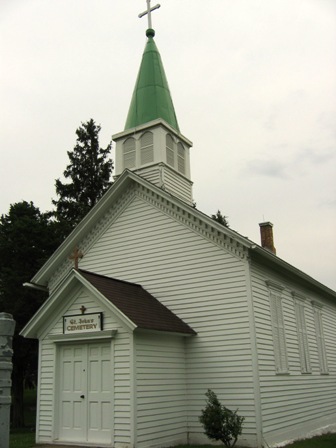
On the highest point, at the southwest corner of Algonquin and Church Roads, rests St John Nepomucene church and cemetery, established in 1867. Both were named after the Catholic patron saint of Bohemia (Bohemia, a kingdom prior to 1918, now a county part of the Czech Republic). This site was primarily organized to fulfill the spiritual needs of 18 Bohemian immigrant families settling in McHenry County during the 1860s.
The cemetery’s first burial occurred around 1871, during the same time construction of the church began. Lumber for the church was acquired in Barrington and hauled there by wagon. An 1872 plat map of Algonquin Township, depicts both as competed that year. In 1874 a bell was purchased and installed, crowning off the white clapboard tower of the newly erected chapel. The bell would signal deaths, births or wedding celebrations.
While the founding congregation was small in this rural southeast corner of McHenry County, it never had a resident priest. Once a year a priest would travel from Chicago by train to Barrington, then by horse and buggy to St. John. During the absence of a priest, a lay parishioner would conduct services in Bohemian (Bohemian used to denote the Czech people as well as the language), their native language.
Today, the cemetery is still open for burials. Older gravestones are to the eastside of the church, and have inscriptions written in Bohemian. Many Catholics from the towns of Fox River Grove, Algonquin and Cary are at rest here.
Early in the 1900s, a gravel driveway was added to the south of the original one acre cemetery, after additional land was acquired. In 2007, a Catholic cemetery association secured ownership of this historic property, preceded by its annexation into Barrington Hills.
The tiny chapel, circa 1872, still in exceptional condition, has been closed for regular worship since 1914. It’s original bell, pews, alter and pump organ are still intact. Fortunately, the interior can be seen annually during a Labor Day celebration Mass, honoring the founding 18 Czech families.
by Bonnie Duresa
Barrington Hills
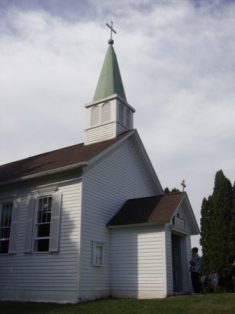
St John Nepomucene Church circa 1872. September 6, 2010 Labor Day Mass.
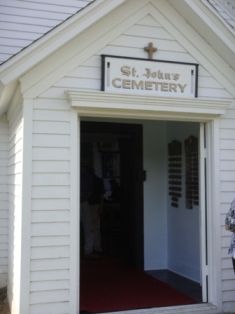
Entrance St. John Nepomucene Church for Sept. 6, 2010 Labor Day Mass.

Sept. 6, 2010 St John Nepomucene Church Labor Day Mass. Early visitors gathering for service.
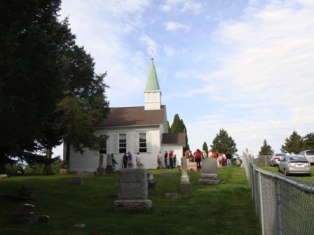
Sept 6, 2010 St John Nepomucene Church and Cemetery. East side of church and cemetery with group attending Labor Day Mass.
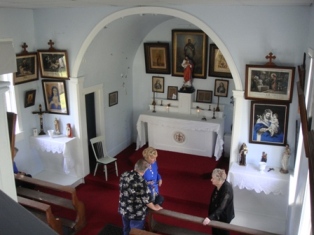
Sept. 6, 2010 St John Nepomucene Church view from upper level. All original 1870s interior alter, pews, framed prints and religious statuary.

Sept 6, 2010 St John Nepomucene Church c.1872 alter and "Stations of the Cross" framed prints. Left side has 7 rows of pews with seating for 5 people each.
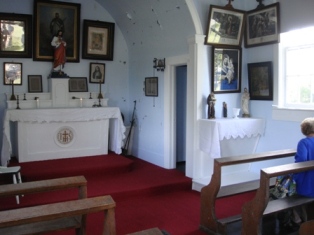
Sept 6, 2010 St John Nepomucene Church c.1872 alter and "Stations of the Cross" framed prints. Right side has 6 rows of pews with seating for 5 people each. Narrow stairway at back to upper level, has access for pump organ and steeple bell rope.
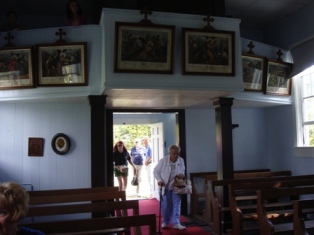
Sept 6, 2010 St.John Nepomucene Church. Interior entrance shows second level that holds 1870 carved pump organ. On upper wall has "Stations of the Cross" original 1870's framed prints.
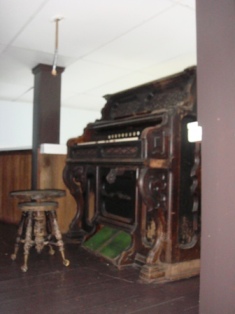
Sept. 6, 2010 St John Nepomucene Church Upper level. Holds 1870 original pump organ with bell rope at ceiling, with one bench with seating for 4 people.

Sept. 6, 2010 St. John Nepomucene Cemetery. South side at rear of church during annual Labor Day Mass.
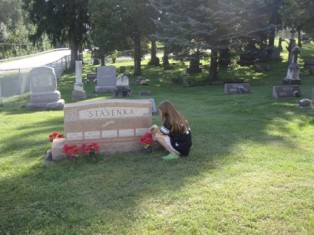
Sept 6, 2010 St. John Nepomucene Church and Cemetery. At the Labor Day Mass, even the young find time to visit those that have passed.
